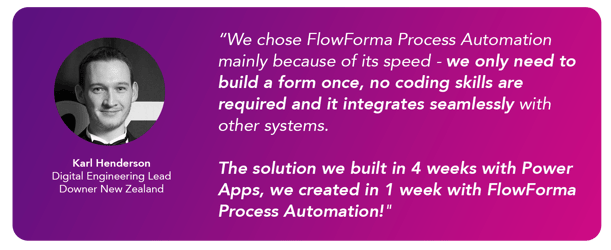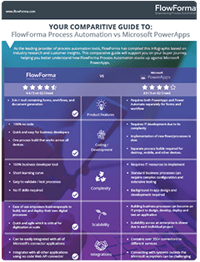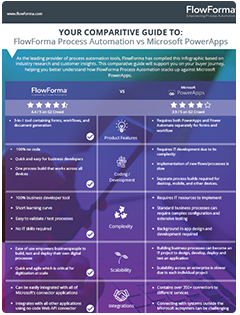In this blog post, I want to provide expert insights into the comparison between Power Apps Vs Power Automate as well as showcase how both platforms stack up against FlowForma Process Automation. From speaking with IT leaders, there are key recurring themes discussed when their organizations have Office 365 in place and have experimented with Microsoft’s Power Apps and Power Automate (formerly known as Microsoft Flow). The conversations usually pertain to functionality, technical comparison and ROI.
There is still a grey area around the strengths and weaknesses of Power Apps and Power Automate, as well as the potential alternatives for digital transformation. In this blog, I will distil the myths and provide a valuable Power Apps Vs Power Automate guide for your organization to follow.
Key highlights include:
- What Are Microsoft Power Apps & MS Power Automate?
- Are Microsoft Power Apps & MS Power Automate Difficult To Use?
- Process Automation Considerations For Power Apps & Power Automate
- Power Apps vs. FlowForma Process Automation
- How to Automate Processes 4x Times Faster Than Power Apps
- How Power Platform Compliments FlowForma Process Automation
- How does FlowForma Process Automation manage risks associated with Citizen Development?
- Comparative Guide to FlowForma Process Automation vs Microsoft Power Apps
What Are Microsoft Power Apps & MS Power Automate?
Microsoft Power Apps is primarily a design tool for forms, while Microsoft Power Automate is an automation and integration tool. They’re individual products but can be combined.
IT professionals comment on the challenges they face in meeting the demand for business process automation and digital transformation from within their organizations.
Feedback in general suggests that process owners find it difficult to build solutions themselves using Power Apps and Power Automate and are knocking on IT’s door to get it done. The user interfaces are undeniably slick and have all the appeal that you expect from any Microsoft product but when you get under the hood it is clear that you need coding experience and a lot of free time to learn both products so that you can make them work together to meet the needs of the business. You quickly realize that it’s outside of your skillset and a ticket/project needs to be logged with IT.
Are Microsoft Power Apps & MS Power Automate Difficult To Use?
When designing forms using Power Apps, you need to use Excel-like expressions to add logic to the forms you are designing. These formulas can become quite complex. So, when problems are encountered, it’s not always a quick fix and often requires IT personnel to resolve them.
Power Apps forms also need a workflow component (Power Automate) to engage the different users in a business process, such as:
- form initiators/requestors
- approvers (often different people at many different stages in a single process)
- fulfillment resources (the people that complete the process by carrying out tasks e.g. HR and finance staff, site operations staff, etc.)
Integrating the two components together to deliver a smooth-running business process can be very challenging. You need to consider:
- How a Power App form will record the progress of a process through its stages?
- How the progress will be updated at each stage?
- How the transfer of responsibility will occur?
- How the communications will be handled between the resources involved in the process?
- How access to data will be managed?
- How documents are generated and managed?
And many more, depending on the complexity of the business process…
Because of these challenges, IT is often left carrying the process automation can. Given that this resource is usually overstretched, organizations are then left with no alternative but to bring in a partner to implement process automation solutions. This can be a costly exercise, as not only do solutions need to be built externally, but they also need to be maintained. It’s common for organizations to encounter other issues i.e. if there is a change in personnel within that partnership. The person who once used ‘their’ logic to create workflows may have moved companies and their coding is often not ‘logical’ to another coder which can introduce delays.
What can we take from the process automation challenges that IT Departments have faced? And what about alternatives to Power Apps & Power Automate for digital transformation at scale?
Process Automation Considerations For Power Apps & Power Automate
What’s important to consider before you take on any process automation solution, is the scale and ownership of your process automation project. How soon do you want or need to digitize and who will be responsible for maintaining processes that are built that may require changes further down the line.
If it’s a few pain point solutions that the business needs, then IT can build and maintain these processes with Power Apps and Power Automate.
But if you are automating multiple processes, then IT's ability to turn these processes around quickly and commit to their continued maintenance can be problematic. This is when it's worth evaluating Power Apps & Power Automate alternatives for digital transformation.
There are many benefits to using a no-code platform, the main one being that the barrier to entry is lowered for digitizing processes and more people can create workflows than with a product that requires coding and working with multiple products.
Power Apps vs. FlowForma Process Automation
With FlowForma Process Automation, process owners can build solutions quickly using one integrated tool that combines forms, workflow, analytics and document generation, in one interface. It’s 100% no code and a great alternative to using Power Apps & Power Automate for digital transformation. By combining everything into one no-code tool, FlowForma significantly reduces the learning time required to build solutions and automatically records performance metrics that demonstrate the value to the business user.

FlowForma Process Automation uses built-in features for workflow, data, and communications management that make the creation of solutions easy for businesspeople. It reduces technical complexity and risk when digitizing processes.
It provides a clear path that matches the way that business users think about processes and systems, with features that give users a helping hand when they need it (no need to search the internet!). Designers can test as they build and refine their solutions as soon as they get feedback from people in the field.
.png?width=700&name=Copy%20of%20Day%20(11).png) Statistics sourced from G2 Comparison Report 2022*
Statistics sourced from G2 Comparison Report 2022*
Hear how Bouygues Energies & Services automated its processes 4x faster using FlowForma compared with PowerApps
Check out the full case study featuring Bouygues Energies here.
How Power Platform Compliments FlowForma Process Automation
There are scenarios where organizations use both Power Platform and FlowForma Process Automation, and here are some examples where it makes good sense to do so:
Power Automate flows can be triggered by many events, for example, receiving an email. Power Automate can then create or update a FlowForma Process Automation form to execute the business process using our Power Automate Connector.
Simple Power Apps can be created easily, so if you need just a simple form for use within your own team, with no business process, then PowerApps is all you need.
Power Apps gives you a significant level of control over the user interface, so if you need a super-slick user interface and have the time to build it, then Power Apps can act as the front-end user interface and can pass data into FlowForma Process Automation using the connector to handle the approval and fulfillment stages of the business process.
Often, IT teams will use Power Apps for their own needs as they have the necessary development skills, while process managers from the business, that need to build out processes quickly and scale fast, use FlowForma Process Automation. The process owners are then confident to create what’s required for the business and maintain it independently of IT. The beauty is that skilling up in FlowForma Process Automation is not a steep learning curve for process managers and once one process is built subsequent processes are easy to replicate and tweak. This flexible approach facilitates the digitization of processes quickly across the organization.
How does FlowForma Process Automation manage risks associated with Citizen Development?
Even if business process owners create solutions themselves, IT will always play a part. Ultimately, IT are the owners of IT risks. They provide the tools to the users and have some responsibility to ensure that the tools are used well. FlowForma provides specific features that allow IT to manage this risk.
FlowForma Governance empowers IT to quickly create sandboxes for process managers, enabling the business to test within their own sandbox without any risk to a production environment. Here they can build flows and test different processes, before applying to IT to have them promoted for day-to-day use by the business. It’s a ‘win-win’ easing the reliance on IT but ensuring that nothing goes awry and that they get the final say before anything goes ‘live’.
Watch this video to learn more about citizen development.
So, to my earlier point, it’s easy to get distracted by the view. Slick interfaces look nice, and we’re naturally drawn to applications with exceptional user interfaces but the ability to create your own workflows consistently, quickly, and with flexibility is key when pressure is on to digitize at pace.
Comparative Guide to FlowForma Process Automation vs Microsoft Power Apps
 For a side-by-side comparison, check out the Comparative Guide to FlowForma Process Automation vs Microsoft Power Apps
For a side-by-side comparison, check out the Comparative Guide to FlowForma Process Automation vs Microsoft Power Apps
If you are looking to move paper processes online, we would be happy to help you. Building processes at scale and in a timely fashion can be a challenge for some at the moment, feel free to get in touch with us and we will do what we can to help.



.jpg)





